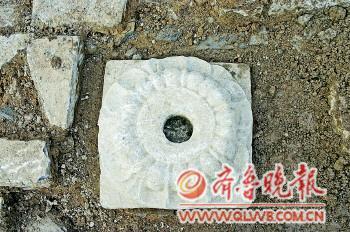source: Qilu Evening News reporter Qiao Xianjia

Xiao Wang Fu site, there are treasures left by the Buddhist temple. Newspaper reporter Qiao Xianjia
reporter 1 days from the Archaeological Research Institute in Ji'nan City, located in the east side of Shun Well Street archaeological excavation workers underground discovered ancient monasteries remains, unearthed a large number of the remains of the time.
the newly discovered remains of the ancient monasteries are located underground and near the ruins of the Wangfu site in Ninghai in the Ming Dynasty. According to the staff of the Ji'nan Institute of archaeology, after the Spring Festival, they continue to excavate the construction site of the wide and thick Street section of the District, hoping to continue to explore the structure of the two Ming Dynasty prefectural prefectural palace in the palace of Ningyang and the Royal Palace of Ninghai, and to find the southern boundary of the Kaiyuan Temple in the city of Ji'nan.
it was introduced that in 2003 and 2006, many Buddhist remains were found on both sides of the County West Lane, proving that there was a monastery site built in the late Northern Dynasty. In the Tang Dynasty, it was renamed Kaiyuan Temple. It was the largest monastery in Ji'nan. In the early Ming Dynasty, the Kaiyuan Temple block was occupied by the government, and the monks were forced to migrate. Some of them migrated to the Buddha Hui mountain in the south of the city. The Buddhist temple was renamed as the Kaiyuan Temple, which continued the first century of the 50s. The central area of Kaiyuan Temple was later used as a Yamen in Ming and Qing Dynasties. Now it is the seat of the Shandong Provincial Political Consultative Conference.
has been excavated continuously. Recently, the archaeologists have discovered some Buddhist relics in the cultural layer of the Tang and Song Dynasties, such as the stone carving lotus flower seat, the stump block, the stump tower tip, the eight prism column and so on. Among them, a piece of remnants of the building contains "Luo Cha ghosts, cloth, single, Nhat Chai"... Big brash seed is born, or must be expensive and expensive... The honor of Ronnie, is like the treasure of the Hun mani... Good and clean, born good way, heaven emperor, this Tuo Ronnie... It is explained by archaeologists that the words of the emperor, the emperor of heaven, if there is a monk, should be taken from a "Buddha top to honor the trun Jing". This was unearthed in the archaeological excavations of the County West Lane in 2003 and 2006, and in 2010 the Tang Dynasty blocks preserved in the underground were found in the construction of the southern end of the County West Lane.
according to the introduction, most of the newly discovered Buddhist relics were found in the underground cultural layer within the Ming Dynasty palace of Ninghai. It was preliminarily conjectured that the southern boundary of the Kaiyuan Temple in the Tang and Song Dynasties may have been here at one time, and the size of the temple was so large. In addition, the Ming Dynasty did not occupy all the boundaries of Kaiyuan Temple. Only in the middle and late Ming Dynasty, the Ninghai palace was built on the site of Kaiyuan Temple.
the staff of Ji'nan Institute of archaeology said that they will make detailed excavation of the key parts next.